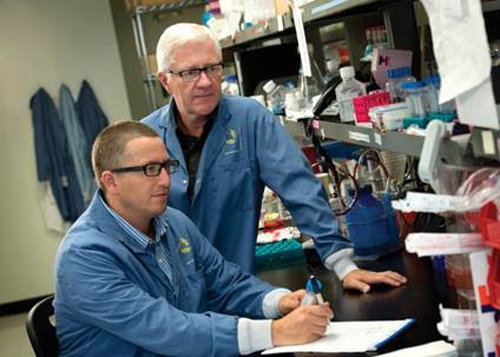
HAIFA (Press Release)–An Israeli physician-scientist is a member of the Toronto research team that discovered a stem cell that may be responsible for initiating leukemia and triggering relapses in patients with acute myeloid leukemia (AML).
The groundbreaking study was published in Nature magazine Feb. 12. The findings show that in about 25 percent of AML patients, a genetic mutation causes pre-leukemic stem cells to develop, functioning like normal blood stem cells. These cells survive chemotherapy and may eventually lead to relapse.
Dr. Liran Shlush, a member of the team, first began studying single leukemic cells and trying to track the disease in 2008, as a recipient of the Itai Sharon Rambam Atidim Award, a fellowship at the Rambam Health Care Campus in Haifa, while serving his residency at Rambam Medical Center.
The award allows young physicians, heavily burdened with clinical work, to still find time for research and seek related opportunities in their fields of specialization.
As a Rambam fellow, Shlush, who holds bachelor’s, doctoral and medical degrees from Technion-Israel Institute of Technology, says he began studying the “dynasties of single cells.” “We learned quite a lot, and we learned that the leukemia cell causing the disease to come back look different than what we saw when the disease was first diagnosed,” he says.
That research laid the ground for the work he did with Dr. John Dick, who led the team at Princess Margaret Cancer Centre in Toronto that was responsible for the study released last week.
The new research finds that AML, an aggressive blood cancer, starts in stem cells in the bone marrow. Shlush describes a parent cell — the pre-leukemic stem cell — that creates a dynasty of malignant cells. Chemotherapy kills that dynasty, but not the parent cell, which the body “thinks is a normal cell.” That parent cell then “creates a new dynasty” of malignancies, Shlush says.
“We always thought that cancer cell survivors” of chemotherapy were responsible for leukemia recurrences, he says. This study finds that the pre-leukemic stem cells “serve as the reserve well for the leukemia to come back.”
The researchers estimate that 3 of 5,000 people have this genetic mutation. The hope now is that a drug can be targeted to destroy the mutation before it develops into cancer. Additionally, the findings may have implications for the treatment of other blood cancers.
“My assumption is most leukemias will behave the same way, but we don’t know,” Shlush says. “It’s definitely possible for other hematological malignancies, but for other cancers it’s hard to say.”
Shlush says it was his time at Rambam that allowed him to become part of Dick’s team. “It’s very difficult to get accepted to this lab; other people’s resumes were better than mine,” he says. “The fact that I did something unique during this one year [at Rambam] captured his eye.”
For scientists, working at Dick’s lab, Shlush says, “is like taking a child who likes candy into a candy store and telling him he can eat anything he likes. Whatever I want I can do. There is no limit to what you can do.”
Dick says that Shlush’s work at Rambam was enormously helpful in this research study. “My lab had no experience in population genetics, nor in advanced genetic analysis. His training in both the clinical and research aspects of leukemia was essential preparation to carry out this study,” says Dick. “His population genetics training has been instrumental in being able to design the right experiments and in interpreting unexpected findings were key.”
Shlush, who grew up in Haifa, says he long wanted to become a doctor. As a child, he says, he “always felt uneasy and dissatisfied when someone was sick and I could not do anything.”
His first forays into research came as a high school student when he spent a month each summer at a kibbutz helping out an uncle who was doing studies on chickens. He continued research projects while in medical school and then while in the Israel Defense Forces, where he served as a battalion medical officer and then as medical commander of the Golani Brigade Training Base, Northern Israel Command.
Shlush praised Rambam for the fellowship that initially allowed him to focus on pre-leukemic cells: “I truly am thankful for their vision and their help.”
*
Preceding provided by Rambam Health Care Campus
*
San Diego Jewish World seeks sponsorships to be placed, as this notice is, just below articles that appear on our site. This is an ideal opportunity for your corporate message or to personally remember a loved one’s contributions to our community. To inquire, call editor Donald H. Harrison at (619) 265-0808 or contact him via donald.harrison@sdjewishworld.com